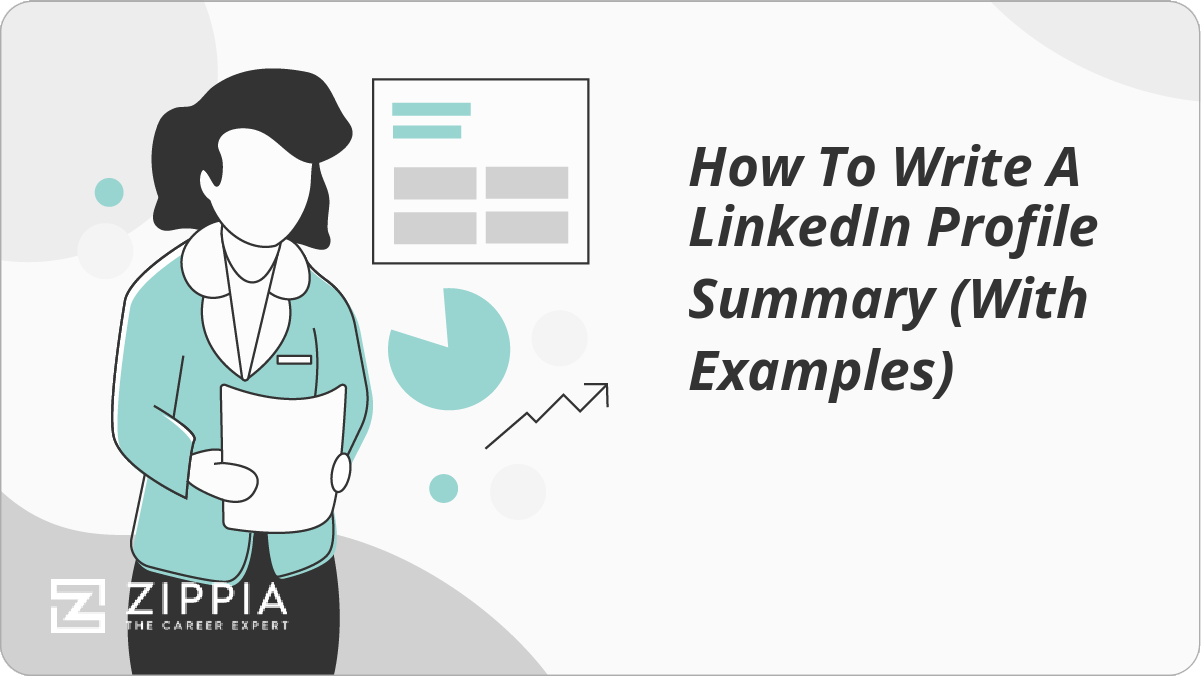- Process
- How Long Does It Take To Find A Job
- How To Find Internships
- How Many Internships Should I Apply To
- Networking Email
- Foreign Service Exam
- Working Abroad
- Organize Your Job Search
- How To Find A Second Job
- How To Get A Job In A New City
- Fun Facts About Me
- Job Search Burnout
- How Old Do You Have To Be To Work?
- Job Review Sites
- How To Become A Freelancer
- Picture
- Choose A Career
- Linkedin Optimization
Find a Job You Really Want In
While it may feel unnecessary with all the other information on your profile, your LinkedIn profile summary is your professional introduction to an audience that can help you improve and further your career.
Because of the importance of a solid LinkedIn profile summary, we’ve put together some instructions on how to write one, some example summaries to use for inspiration, and some more information on what LinkedIn profile summaries are and why they’re important.
Key Takeaways
-
Your LinkedIn profile summary should include your current job, your strengths and accomplishments, and a call to action.
-
Let your personality shine through in your summary by telling stories, sharing about your personal life, and being creative in your writing.
-
Use your LinkedIn profile summary to explain what you do and why you do it.

How to Write a LinkedIn Profile Summary
-
Decide on first or third person. The first decision you have to make when it comes to your LinkedIn profile summary is if you want to write in the first or third person. Either choice is appropriate for a profile summary since it should have a more informal tone.
Deciding to use the third person establishes your profile as more of a professional brand. Using a first-person voice can give your summary a more conversational tone.
For almost all job-seekers, we recommend the first person voice (“I” instead of “he/she/they”) — unless you’re a major celebrity, folks reading your profile know that you’re the one who wrote it.
-
Decide what action do you want the reader to take. Before writing a word of your LinkedIn summary, you need to decide your profile’s goal. A freelancer who wants to attract clients to work for will handle their profile completely differently than a business that wants to attract sales.
Think about what action you want the reader of your summary to take once they’ve digested the information.
-
State your current role and company. Initiate the reader into your summary by stating your professional responsibilities and the company you work for, if applicable. You don’t necessarily have to make this the first sentence of your summary because you’ll likely want to use something catchier than just your job title.
However, make sure the reader understands your job by the time they finish reading your LinkedIn profile summary.
-
Highlight strengths and accomplishments. You want your LinkedIn profile summary to impress the reader. You don’t want to simply reiterate your resume. Instead, focus on your most significant accomplishments and skills that make you stand out from the crowd.
When discussing your achievements and skills, be as specific as possible. Include statistics or other empirical proof of your abilities when possible to strengthen your summary.
-
Get creative and let your personality shine through. Someone who comes to your LinkedIn profile to read your summary will most likely be more interested in your character than your professional history. Use your LinkedIn summary as a creative platform to express who you are beyond your career and make people want to work with you in the future.
The Structure of a LinkedIn Profile Summary
LinkedIn profile summaries follow a pretty straightforward and easily replicable format. Here’s a three-step breakdown that almost all winning LinkedIn profiles incorporate:
-
A catchy opening line. It’s critical to start out with something more interesting than “My name is X and I work at Y as a Z.” Yawn. Instead, consider what aspects of your career would interest people, how you’re different than others in your field, a compelling story about how you got into the business, etc., etc.
There are countless ways to be interesting while still keeping things professionally relevant. We recommend a judgment-free brainstorming session where you spit out as many opening lines as you can think of (even if they sound ridiculous and silly). Chances are, you’ll find a gem in there somewhere.
You don’t have to have one single opening line, either. Sometimes a quick series of short sentences to start things off can also be rhetorically effective.
-
An engaging and descriptive body section. The body of your summary is where you want to use keywords relevant to your field, describe your passions, accomplishments, etc.
You can think of this section as your elevator pitch — 100 or so words on why you’re awesome and love doing what you do. Don’t worry about going overly “cover letter” with this part — not everything has to be totally job-related. Anything that shows how your mind works and gets people interested in talking to you is valuable stuff here.
-
Invite an action. What action you want the reader to take depends on your goals (more on that below), but it’s always good to finish things off by giving the reader something to do (if they want).
If you’re at a loss or you have no specific goals with your LinkedIn page currently, a standard closer like “Message me to chat more about XYZ” is perfectly fine.
Examples of LinkedIn Profile Summaries and Why They Work
Example #1 – Real Estate Agent
Finding a house is one of the most stressful and incredible experiences that a person can have. Without the right person to guide you through the process of finding and securing a home, you can end up somewhere that you don’t want to call home.
Brianna Clarkson is the real estate agent for you if you aren’t satisfied with anything less than the perfect home. In a career that spans over a decade, Brianna has helped over 250 home buyers find their forever place.
When she’s not helping people’s home and interior features dreams come true, Brianna enjoys rock climbing with her fiancé and going for runs with her dog, Bones.
Why It Works: Briana’s LinkedIn profile summary works because it draws the audience into what she has to say by providing them with what they want: to find the perfect home. She focuses most of her profile summary on what the reader can get out of the relationship because she wants to build a clientele and makes note of her accomplishments in the industry to demonstrate proof of her experience
Example #2 – Social Media Manager
I became a social media manager because I love organizing a brand’s image to bring them to their full potential. I enjoy using analytic tools to help you build your brand on social media and improve your overall business growth. While there are a lot of social media managers out there, here are a few reasons why I think I’m the one you need.
My primary goal is to help you and your business reach its full potential
My former clients have seen sales profit margins improve by 3%
I’ve worked with major corporations to assist in building an online presence
Graduated in 2014 bachelor’s degree in business management
I have experience with various platforms like Twitter, Instagram, and Snapchat
I’m always open to learning more
Why It Works: This LinkedIn summary example uses a bullet point list structure to explain their skills and experience in the social media industry, similar to a resume format. This approach works because it makes it clear what the important points are. The reader doesn’t have to go looking through paragraphs for examples of their abilities because they’ve already been outlined. This LinkedIn summary is also on the short side but still hits all the information they need to get across.
Example #3 – English Language Teacher
When I was 19, I knew that I had a passion for two things: language and connecting with people. I decided to travel to Japan to get my TEFL certificate and teach 4th-grade students how to speak English. The experience was more than I can explain, so let’s just say, incredible.
As I got older and gained more experience, I knew that I wanted to bring my teaching skills to adult English learners from different countries. Since then, I’ve been working to bring top-notch conversational English lessons to people around the world. In addition to the in-person classroom, I established an online English school called “James Teaches English,” where students can virtually learn through lesson plans designed by yours truly. The course has had over 2,500 downloads in the past two years.
I continue to work as an international English teacher for the same reasons that initially inspired me when I was 19: language and people.
Why It Works: This example of a LinkedIn summary goes for a first-person voice, and it gives the writing a more casual tone. It works because the writer describes their professional life succinctly and in a way that makes the reader connect with their story. Within the timeline approach taken with this summary, the writer still manages to describe their accomplishments and brand themselves in a distinct way that illustrates their passion for the field.
Example #4 – Administrative Assistant
Adam Darren is an administrative assistant with seven years of experience. He currently works for a property management company called Allhomes Property Management, where he is responsible for the majority of clerical tasks around the office.
Adam has been recognized for his outstanding performance in the form of two promotions over the course of the past three years.
In his spare time, Adam enjoys biking and takes place in a county-wide triathlon every year.
Skills: Time management, Microsoft, Quickbooks, Calendar Management, Communication
Why It Works: Adam’s profile summary is the shortest on the list of examples, but it still provides enough details to inform the reader about his professional experience. This LinkedIn bio works because it’s extremely straightforward. Sometimes, an employer isn’t looking for the most creative profile, but the one who is the most direct.
Adam also adds a little bit of character to his summary by including the ending about how he enjoys spending his free time.
Example #5 – Therapist
The first thing that anyone says when describing me is, “Erin loves her work!”. I’m not only good at providing my patients with mental clarity or a listening ear in times of need, but I also enjoy doing it.
I’ve been working as a therapist for the past twelve years. In that time, I’ve gained invaluable skills in communication, understanding, and patience that I bring to every session. I specialize in helping people in their teenage years cope with grief, anxiety, and the hard parts of becoming an adult. I choose to work with teenagers because I believe that they need someone to confide in without judgment more than any other age group. It’s a unique time in a young person’s life, and I aim to help them through it.
I’m motivated by creating a comfortable place for my clients in my practice, and knowing that I’m helping just one person makes my career choices worth it.
I currently live in Portland, Oregon with my human family of three and my dog family of two.
Why It Works: Erin’s LinkedIn summary is more personal and confident. It feels like a conversation over coffee with an old friend, which is a strong way to tackle creating a profile summary. It works because the main focus is her passion for her job. This sentiment will resonate with both clients looking for a therapist who will put their needs first and an employer looking for a candidate who cares deeply about their job.
Tips For Writing A LinkedIn Profile Summary
-
Be yourself. The most important part of creating a LinkedIn profile summary is being yourself. A summary description that sounds too rigid or gives the impression that you’re trying to be something you’re not will make readers less likely to believe anything you have to say.
Don’t just state the boring facts that come along with your job. Readers of your profile should be attracted by both your professional expertise and your personality.
-
Consider keywords. When hiring managers for competitive jobs are looking to fill an open position on their team, they search for applicants using keywords.
Keywords are words and phrases that are used as search terms to find a specific result. You don’t need to get into the nitty-gritty of search engine optimization to succeed, but consider what keywords would be most beneficial for bringing traffic to your profile.
-
Be concise. Although LinkedIn offers its users up to 2,000 words to create their summary, you may not need to make yours that long. Professionals with a long history and lots of accomplishments to discuss should feel free to use as much space as they need, but overall, it’s best to keep your profile summary concise.
If you decide to make a longer summary, put the most crucial information you want to convey early. Unless a reader is completely engrossed in your summary, they probably won’t keep reading past the first few paragraphs, so make sure they walk away with the crucial details.
-
Think about proof. It’s not 100% necessary, but adding a bit of evidence to your profile summary can be really effective for certain readers. This can range from including certifications from accredited bodies in your field to including a link to your professional portfolio.
Social proof is also great for certain roles. Some examples include a quote from a former client/colleague, a link to an article where you were quoted as an expert, or awards you’ve received from your past employers or organizations in your industry/field. Anything that says “other people agree — I really am awesome.”
-
Tell a story. Stories grab readers’ attention and help them remember you. You don’t need to launch into a pages-long epic about the first time you fed a baby bird and how it inspired you to become a veterinarian, but a quick sentence or two about it will stick in people’s minds.
Show people what you’re passionate about and why, don’t just tell them.
-
Proofread. Even if you aren’t a professional writer, your LinkedIn summary needs to be error-free. Hiring managers will be distracted by typos and will get the impression you’re sloppy in your work, which they don’t want in an employee.
If you aren’t confident in your grammatical skills, have someone who is good in that area read over your summary for you. Or, run it through an online grammar checking program to make sure you don’t have any glaring errors.
What Is a LinkedIn Profile Summary?
A profile summary on LinkedIn functions as your professional bio for your page. It’s a brief synopsis of your work experience, job title, and relevant skills A good profile summary will also showcase your unique personality to attract clients or land a job.
After reading your LinkedIn summary, a potential employer or client should have a clear picture of your career, why you do it, and perhaps most important, why you’re good at it. The profile summary acts as a preview into a particular person’s career.
Why Is Writing a LinkedIn Profile Summary Important?
There are millions of profiles on LinkedIn, and a lot of those people are probably submitting resumes for the same positions that you are. A strong profile summary is critical because it draws a reader into your page and informs them about what you have to offer.
Put yourself in the position of a company whose hiring for an open position. They review an overwhelming amount of applications, resumes, and LinkedIn profiles. There needs to be a reason that they remember your name among all the other applicants.
A well-crafted LinkedIn profile summary will grab their attention and give them the information they need quickly to know that you’re a good candidate and help you get a job that you applied for online.
Even though it may be challenging to write a LinkedIn profile summary, view it as an opportunity to connect with professionals in your field instead of a task.
- Process
- How Long Does It Take To Find A Job
- How To Find Internships
- How Many Internships Should I Apply To
- Networking Email
- Foreign Service Exam
- Working Abroad
- Organize Your Job Search
- How To Find A Second Job
- How To Get A Job In A New City
- Fun Facts About Me
- Job Search Burnout
- How Old Do You Have To Be To Work?
- Job Review Sites
- How To Become A Freelancer
- Picture
- Choose A Career
- Linkedin Optimization





